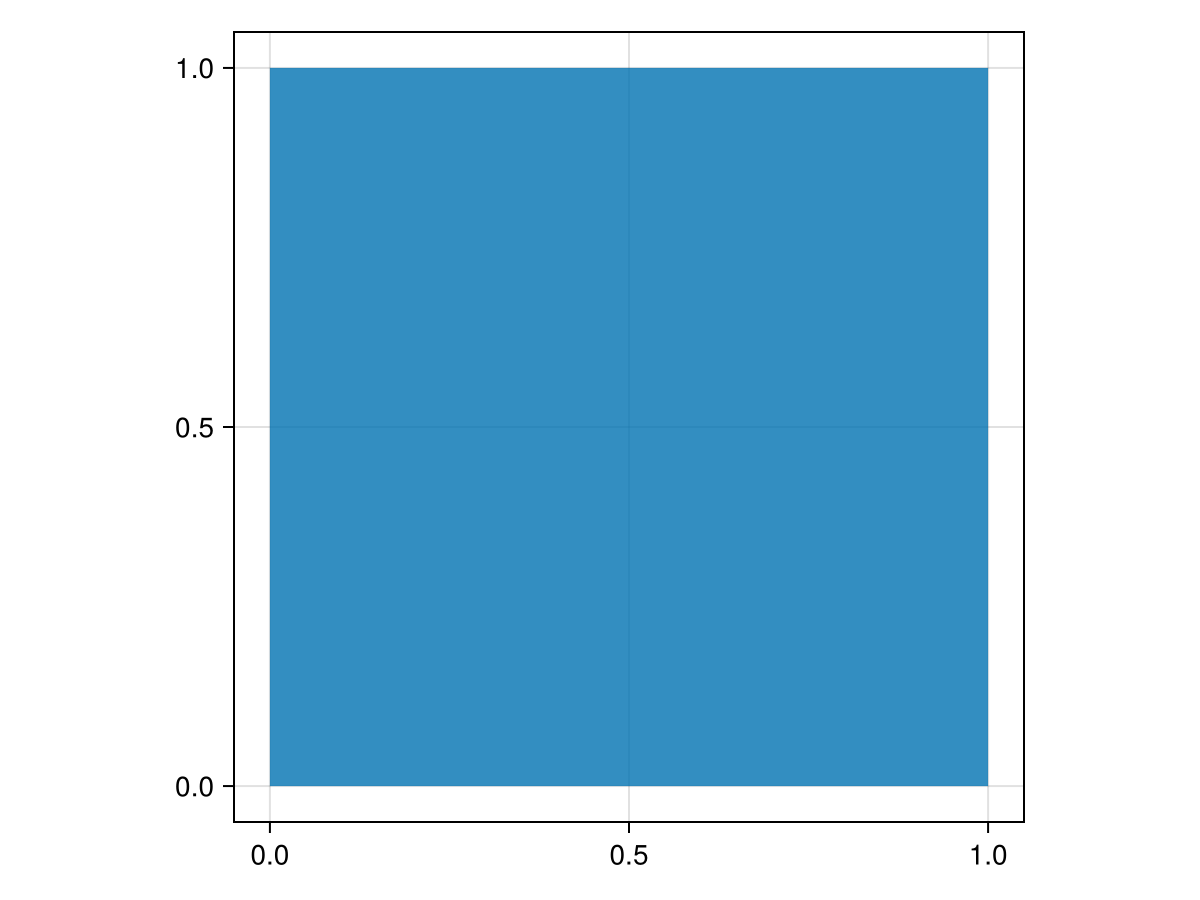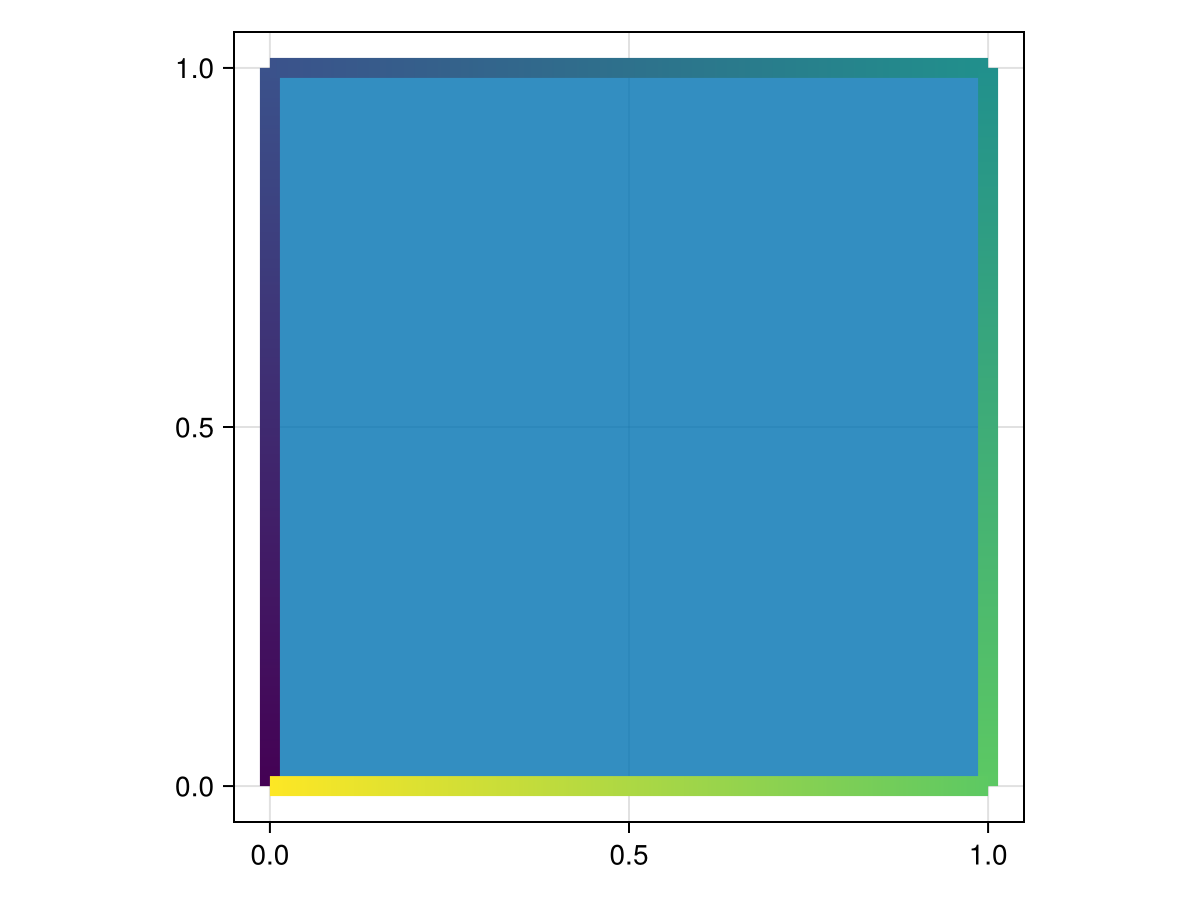Area and signed area
export area, signed_areaWhat is area? What is signed area?
Area is the amount of space occupied by a two-dimensional figure. It is always a positive value. Signed area is simply the integral over the exterior path of a polygon, minus the sum of integrals over its interior holes. It is signed such that a clockwise path has a positive area, and a counterclockwise path has a negative area. The area is the absolute value of the signed area.
To provide an example, consider this rectangle:
import GeometryOps as GO
import GeoInterface as GI
using Makie
using CairoMakie
rect = GI.Polygon([[(0,0), (0,1), (1,1), (1,0), (0, 0)]])
f, a, p = poly(collect(GI.getpoint(rect)); axis = (; aspect = DataAspect()))
This is clearly a rectangle, etc. But now let's look at how the points look:
lines!(
collect(GI.getpoint(rect));
color = 1:GI.npoint(rect), linewidth = 10.0)
f
The points are ordered in a counterclockwise fashion, which means that the signed area is negative. If we reverse the order of the points, we get a postive area.
GO.signed_area(rect) # -1.0-1.0Implementation
This is the GeoInterface-compatible implementation. First, we implement a wrapper method that dispatches to the correct implementation based on the geometry trait. This is also used in the implementation, since it's a lot less work!
Note that area and signed area are zero for all points and curves, even if the curves are closed like with a linear ring. Also note that signed area really only makes sense for polygons, given with a multipolygon can have several polygons each with a different orientation and thus the absolute value of the signed area might not be the area. This is why signed area is only implemented for polygons.
Targets for applys functions
const _AREA_TARGETS = TraitTarget{Union{GI.PolygonTrait,GI.AbstractCurveTrait,GI.MultiPointTrait,GI.PointTrait}}()
"""
area(geom, [T = Float64])::T
Returns the area of a geometry or collection of geometries.
This is computed slightly differently for different geometries:
- The area of a point/multipoint is always zero.
- The area of a curve/multicurve is always zero.
- The area of a polygon is the absolute value of the signed area.
- The area multi-polygon is the sum of the areas of all of the sub-polygons.
- The area of a geometry collection, feature collection of array/iterable
is the sum of the areas of all of the sub-geometries.
Result will be of type T, where T is an optional argument with a default value
of Float64.
"""
function area(geom, ::Type{T} = Float64; threaded=false) where T <: AbstractFloat
applyreduce(+, _AREA_TARGETS, geom; threaded, init=zero(T)) do g
_area(T, GI.trait(g), g)
end
end
"""
signed_area(geom, [T = Float64])::T
Returns the signed area of a single geometry, based on winding order.
This is computed slighly differently for different geometries:
- The signed area of a point is always zero.
- The signed area of a curve is always zero.
- The signed area of a polygon is computed with the shoelace formula and is
positive if the polygon coordinates wind clockwise and negative if
counterclockwise.
- You cannot compute the signed area of a multipolygon as it doesn't have a
meaning as each sub-polygon could have a different winding order.
Result will be of type T, where T is an optional argument with a default value
of Float64.
"""
signed_area(geom, ::Type{T} = Float64) where T <: AbstractFloat =
_signed_area(T, GI.trait(geom), geom)Points, MultiPoints, Curves, MultiCurves
_area(::Type{T}, ::GI.AbstractGeometryTrait, geom) where T = zero(T)
_signed_area(::Type{T}, ::GI.AbstractGeometryTrait, geom) where T = zero(T)LibGEOS treats linear rings as zero area. I disagree with that but we should probably maintain compatibility...
_area(::Type{T}, tr::GI.LinearRingTrait, geom) where T = 0 # could be abs(_signed_area(T, tr, geom))
_signed_area(::Type{T}, ::GI.LinearRingTrait, geom) where T = 0 # could be _signed_area(T, tr, geom)Polygons
_area(::Type{T}, trait::GI.PolygonTrait, poly) where T =
abs(_signed_area(T, trait, poly))
function _signed_area(::Type{T}, ::GI.PolygonTrait, poly) where T
GI.isempty(poly) && return zero(T)
s_area = _signed_area(T, GI.getexterior(poly))
area = abs(s_area)
area == 0 && return areaRemove hole areas from total
for hole in GI.gethole(poly)
area -= abs(_signed_area(T, hole))
endWinding of exterior ring determines sign
return area * sign(s_area)
endOne term of the shoelace area formula
_area_component(p1, p2) = GI.x(p1) * GI.y(p2) - GI.y(p1) * GI.x(p2)
#= Calculates the signed area of a given curve. This is equivalent to integrating
to find the area under the curve. Even if curve isn't explicitly closed by
repeating the first point at the end of the coordinates, curve is still assumed
to be closed. =#
function _signed_area(::Type{T}, geom) where T
area = zero(T)
np = GI.npoint(geom)
np == 0 && return area
first = true
local pfirst, p1Integrate the area under the curve
for p2 in GI.getpoint(geom)Skip the first and do it later This lets us work within one iteration over geom, which means on C call when using points from external libraries.
if first
p1 = pfirst = p2
first = false
continue
endAccumulate the area into area
area += _area_component(p1, p2)
p1 = p2
endComplete the last edge. If the first and last where the same this will be zero
p2 = pfirst
area += _area_component(p1, p2)
return T(area / 2)
endThis page was generated using Literate.jl.